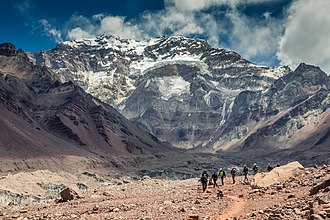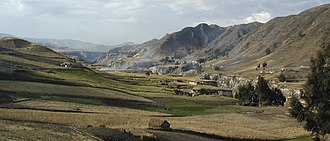Andes





The Andes are the longest continental mountain range in the world, stretching along the western coast of South America. This vast range extends from Venezuela in the north, passing through Colombia, Ecuador, Peru, Bolivia, Chile, and reaching its southern end in Argentina. The Andes play a crucial role in the cultural, social, and economic life of the South American countries they traverse, influencing climate patterns, agriculture, and biodiversity.
Geography[edit]
The Andes mountain range is approximately 7,000 kilometers (4,300 miles) long and varies in width from 200 to 700 kilometers (120 to 430 miles). The range boasts some of the highest peaks in the world outside of Asia, with Aconcagua being the highest at about 6,961 meters (22,838 feet) above sea level, located in Argentina near the Chilean border. The Andes are not a single line of towering peaks but a complex series of mountain ranges, or cordilleras, with high plateaus and valleys in between.
Geology[edit]
The Andes were formed from the collision of the South American Plate and the Nazca Plate, a process that began in the Late Jurassic period and continues today, making the Andes a seismically active area with frequent earthquakes and volcanic eruptions. The mountain range is home to numerous volcanoes, forming part of the Pacific Ring of Fire. The geological activity has created a rich variety of mineral resources in the Andes, including copper, silver, and gold, which have been mined for centuries.
Climate[edit]
The climate in the Andes varies greatly depending on latitude, altitude, and proximity to the sea. The range can experience a wide range of climate types, from tropical in the north to polar in the far south. The altitude affects temperature significantly, with higher elevations having cooler temperatures. The Andes also significantly influence regional climate patterns, including the Amazon basin's rainfall, by acting as a barrier to moisture-laden winds from the Atlantic Ocean.
Biodiversity[edit]
The Andes are one of the most biodiverse regions in the world, with a wide range of habitats from tropical rainforests in the lower elevations to glaciers at the highest elevations. This diversity of ecosystems supports a vast array of plant and animal species, many of which are endemic to the Andes. The mountain range is a hotspot for biodiversity conservation due to the high number of species and the threats posed by climate change and human activities.
Culture[edit]
The Andes have been inhabited for thousands of years, with pre-Columbian civilizations like the Inca Empire leaving a lasting legacy in the region. The mountains continue to be a significant cultural and spiritual symbol for the indigenous peoples living there. Traditional ways of life, including agriculture, herding, and weaving, persist alongside modern developments. The Andes also influence the culture of the entire continent through music, literature, and cuisine that have roots in the mountainous landscape.
Challenges[edit]
The Andes face several environmental and social challenges. Climate change poses a significant threat, with glaciers retreating at an alarming rate, which affects water availability for millions of people. Deforestation and mining also have adverse effects on the region's biodiversity and the livelihoods of local communities. Additionally, the Andes are prone to natural disasters such as landslides and volcanic eruptions, which can have devastating impacts on the densely populated areas.
Conclusion[edit]
The Andes are a vital part of South America's physical geography and cultural identity. Their majestic landscapes, rich biodiversity, and complex ecosystems make them an area of significant scientific interest and a popular destination for tourists seeking adventure and natural beauty. However, the challenges they face require concerted efforts for sustainable management and conservation to ensure they continue to thrive for future generations.
Ad. Transform your life with W8MD's Budget GLP-1 injections from $75


W8MD offers a medical weight loss program to lose weight in Philadelphia. Our physician-supervised medical weight loss provides:
- Weight loss injections in NYC (generic and brand names):
- Zepbound / Mounjaro, Wegovy / Ozempic, Saxenda
- Most insurances accepted or discounted self-pay rates. We will obtain insurance prior authorizations if needed.
- Generic GLP1 weight loss injections from $75 for the starting dose.
- Also offer prescription weight loss medications including Phentermine, Qsymia, Diethylpropion, Contrave etc.
NYC weight loss doctor appointmentsNYC weight loss doctor appointments
Start your NYC weight loss journey today at our NYC medical weight loss and Philadelphia medical weight loss clinics.
- Call 718-946-5500 to lose weight in NYC or for medical weight loss in Philadelphia 215-676-2334.
- Tags:NYC medical weight loss, Philadelphia lose weight Zepbound NYC, Budget GLP1 weight loss injections, Wegovy Philadelphia, Wegovy NYC, Philadelphia medical weight loss, Brookly weight loss and Wegovy NYC
|
WikiMD's Wellness Encyclopedia |
| Let Food Be Thy Medicine Medicine Thy Food - Hippocrates |
Medical Disclaimer: WikiMD is not a substitute for professional medical advice. The information on WikiMD is provided as an information resource only, may be incorrect, outdated or misleading, and is not to be used or relied on for any diagnostic or treatment purposes. Please consult your health care provider before making any healthcare decisions or for guidance about a specific medical condition. WikiMD expressly disclaims responsibility, and shall have no liability, for any damages, loss, injury, or liability whatsoever suffered as a result of your reliance on the information contained in this site. By visiting this site you agree to the foregoing terms and conditions, which may from time to time be changed or supplemented by WikiMD. If you do not agree to the foregoing terms and conditions, you should not enter or use this site. See full disclaimer.
Credits:Most images are courtesy of Wikimedia commons, and templates, categories Wikipedia, licensed under CC BY SA or similar.
Translate this page: - East Asian
中文,
日本,
한국어,
South Asian
हिन्दी,
தமிழ்,
తెలుగు,
Urdu,
ಕನ್ನಡ,
Southeast Asian
Indonesian,
Vietnamese,
Thai,
မြန်မာဘာသာ,
বাংলা
European
español,
Deutsch,
français,
Greek,
português do Brasil,
polski,
română,
русский,
Nederlands,
norsk,
svenska,
suomi,
Italian
Middle Eastern & African
عربى,
Turkish,
Persian,
Hebrew,
Afrikaans,
isiZulu,
Kiswahili,
Other
Bulgarian,
Hungarian,
Czech,
Swedish,
മലയാളം,
मराठी,
ਪੰਜਾਬੀ,
ગુજરાતી,
Portuguese,
Ukrainian
